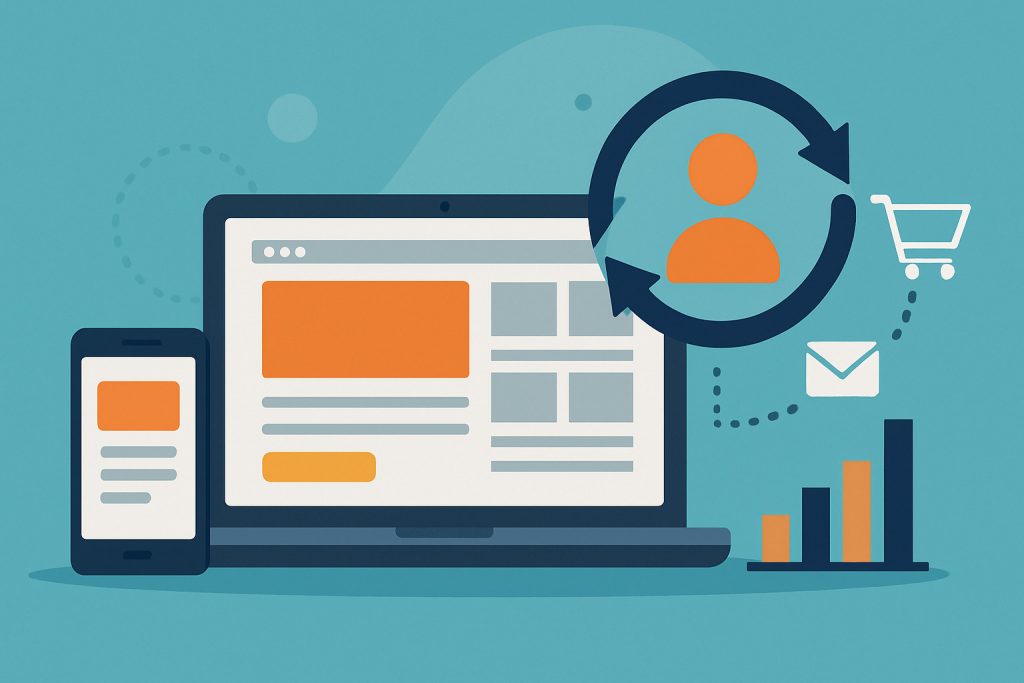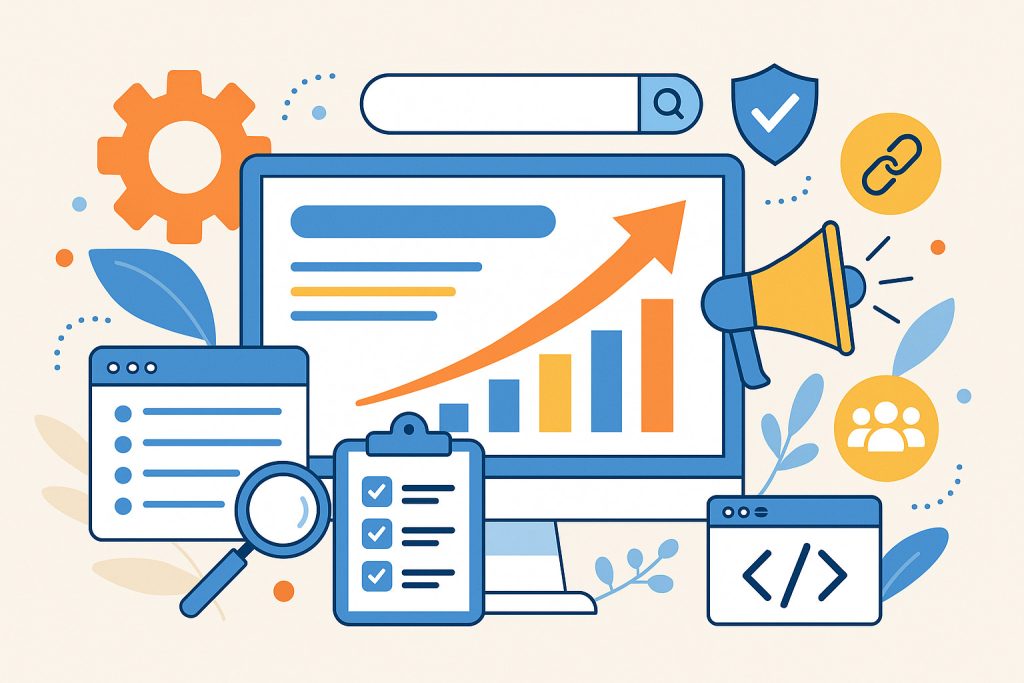In today’s digital landscape, a well-defined roadmap is essential for businesses aiming to achieve impactful online goals. To get there, it’s critical to develop a digital strategy that provides clear direction and aligns with specific, measurable objectives. This roadmap serves as a practical guide to keep your efforts focused, ensuring that each step contributes to meaningful growth. In this article, we’ll outline how to assess your current position, set achievable goals, track progress with KPIs, and make data-driven improvements. Let’s start building a roadmap that positions your business for online success.
1. Assess Where You Are Now
Before setting any goals, it’s important to understand your current digital landscape. Start by asking:
- What are your current strengths and weaknesses online?
- Where does your digital presence stand against competitors?
- What digital channels are performing well, and which need attention?
Conduct an analysis of your website traffic, social media engagement, and conversion rates. This will provide a baseline for your progress. Use analytics tools to gain a clear picture, focusing on metrics like page visits, bounce rate, and conversion rate.
Checklist for Current Status Assessment:
- Review website analytics for user engagement.
- Audit social media platforms for follower growth and engagement.
- Evaluate content performance and identify high-performing posts.
2. Define Your Core Objectives
Setting specific objectives is key to shaping your digital roadmap. Objectives should be clear, specific, and attainable within a given timeframe. Each objective should connect with the broader digital strategy with business objectives for measurable impact. Examples might include:
- Increasing website traffic by 20% within six months.
- Improving the conversion rate by 5% over the next quarter.
- Building a following of 1,000 new subscribers on social media by year-end.
Each objective should align with broader business goals. For instance, if the goal is brand growth, increasing social media presence or expanding content reach may be essential. Make sure objectives are realistic and trackable.
SMART Goals for Digital Success:
- Specific: Clearly define what you want to achieve.
- Measurable: Ensure progress can be tracked.
- Achievable: Set goals that are challenging yet attainable.
- Relevant: Align goals with business objectives.
- Time-bound: Specify when each goal should be met.
3. Prioritize Key Performance Indicators (KPIs)
Key Performance Indicators (KPIs) help measure success and guide adjustments along the way. Using data analytics in digital marketing helps measure KPIs accurately and guides adjustments for effective strategy execution. Examples of KPIs include:
- Website Traffic: Track unique visitors, page views, and session duration.
- Conversion Rate: Measure the percentage of users who complete a desired action.
- Social Media Engagement: Monitor likes, shares, comments, and follower growth.
- Email Open Rate: Observe how many recipients open and click through your emails.
Identify which KPIs are relevant to each objective. For example, if you’re focusing on lead generation, conversion rate and email subscription growth may be primary KPIs. Regularly review these metrics to see if you’re on track or if adjustments are needed.
4. Set a Budget and Allocate Resources
A digital roadmap requires both time and resources, so it’s essential to allocate a budget for the strategies that will support your goals. Consider these resource allocations:
- Paid Advertising: Plan for ads on Google, Facebook, or other platforms.
- Content Creation: Invest in quality content creation, such as blog posts, videos, and social media content.
- Tools and Software: Subscription to essential tools like SEO software, social media schedulers, and analytics platforms.
Assign team members to specific tasks and ensure they have the necessary tools to execute their roles effectively. If outsourcing is part of your strategy, identify areas such as content creation or graphic design where external expertise might be beneficial.
5. Outline Specific Action Steps
Breaking down your objectives into actionable steps makes them more manageable. For each goal, create a set of actions that directly contribute to achieving it. Example actions might include:
- Publishing two new blog posts weekly to drive traffic.
- Posting three times a week on social media to increase engagement.
- Running A/B tests on landing pages to improve conversions.
Establish a timeline for each action step and assign accountability. This ensures everyone knows their responsibilities and deadlines. Actions should be tangible and straightforward to avoid delays and confusion.
Sample Action Plan for Increasing Social Media Followers:
- Week 1-2: Develop a content calendar focusing on trending topics.
- Week 3-4: Launch a small contest to encourage shares and engagement.
- Ongoing: Post daily stories to engage with the audience directly.
6. Build and Optimize Digital Channels
For an effective digital roadmap, optimize your main digital channels. Each platform serves a unique purpose, and consistency is key. Here’s how to approach each one:
- Website: Ensure your website is optimized for speed, mobile compatibility, and user experience. Regularly update content to keep users engaged.
- Social Media: Develop a cohesive content strategy tailored to each platform. Consistent posting schedules and interactive content help build a loyal following.
- Email Marketing: Focus on segmented email lists to ensure tailored content reaches the right audience. Optimize subject lines and track open rates.
- SEO: Conduct keyword research to optimize content, focusing on relevant search terms that align with user intent.
Each digital channel needs attention, but prioritize based on what will have the most significant impact on your goals.
7. Create Engaging Content that Adds Value
Content drives user engagement and helps achieve goals, whether you’re aiming to increase traffic or build brand awareness. Develop a content calendar that aligns with user interests and includes:
- Blog Posts: Write informative and relevant articles to attract organic traffic.
- Videos and Graphics: Create visual content that resonates with audiences on social media.
- Email Newsletters: Share valuable updates, product releases, or tips to keep subscribers engaged.
Regularly review content performance and adjust based on feedback and analytics. If a particular blog post is driving significant traffic, consider creating similar content to maintain interest.
8. Implement Regular Review and Feedback Loops
Setting goals is not a one-time task; it requires regular reviews to stay on course. Schedule monthly or quarterly reviews to evaluate progress. During each review, ask:
- Are we meeting our KPIs?
- What areas need improvement?
- Are resources allocated effectively?
Feedback from team members and customers can also guide adjustments. Use surveys, polls, or direct feedback from clients to understand what’s working and where to improve.
9. Make Data-Driven Adjustments
Data is vital to refining your roadmap. If certain strategies aren’t delivering the expected results, adjust based on data insights. For instance:
- Low Website Traffic: If traffic is below expectations, consider adding SEO improvements or paid campaigns.
- High Bounce Rate: Test different page designs or content formats to retain visitors.
- Low Conversion Rate: Adjust calls-to-action or review your product offerings to align better with user needs.
Use analytics tools to monitor KPIs regularly and make incremental adjustments. This data-driven approach keeps your roadmap agile and aligned with evolving business needs.
10. Celebrate Milestones and Reflect on Progress
Achieving goals is a journey, and celebrating milestones keeps the momentum going. When your team hits a target, acknowledge the accomplishment and analyze what worked well. This builds a culture of achievement and motivation.
Reflect on challenges encountered along the way to learn from any missteps. Use these insights for future planning, ensuring each phase of your digital roadmap becomes more efficient.
Conclusion
A well-planned digital roadmap offers a clear path for reaching achievable online goals. From setting specific objectives to tracking KPIs, creating actionable steps, and making data-driven adjustments, a digital roadmap helps businesses navigate their online journey effectively. By focusing on these structured steps, your business can build a sustainable digital strategy that fosters growth, engages your audience, and drives long-term success.





